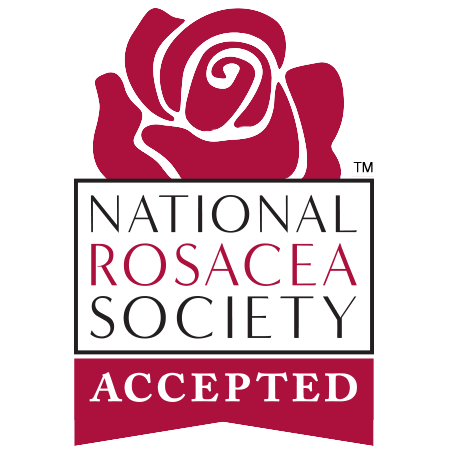Rosacea | 13 June 2025
How to manage rosacea
Do you often wonder why your face is always red? Persistent redness on your cheeks that doesn't fade or a burning sensation that leaves your skin feeling flushed may be signs of rosacea. This is a common skin condition for many people. In fact, according to the National Rosacea Society, over 16 million Americans are affected by symptoms.
Whether you’ve just spotted your first signs or you've been trying to manage symptoms for a while, understanding rosacea is the first step toward calming your skin. To help you, this guide looks at what rosacea is and its causes, plus how to introduce suitable skincare products.
What is rosacea?
Rosacea is a chronic inflammatory skin condition that mostly affects the face. It tends to develop gradually and often cycles between flare-ups and periods of remission. It's not curable but it can be treated.
Some skin types are more susceptible to this condition than others. It tends to affect those with fair skin that's sensitive to the sun's rays and can especially affect those of Celtic origin.
The four types of rosacea
- Erythematotelangiectatic rosacea: This is the most common type. It causes flushing, redness and visible blood vessels, mostly on the face, but sometimes on the neck and scalp.
- Papulopustular rosacea: This features breakouts of red bumps and/or pus bumps. These blemishes can be painful.
- Phymatous rosacea: The skin thickens and there's an irregular surface across the nose, chin, or forehead. In this case, skin has a similar texture to scar tissue.
- Ocular rosacea: This is redness and inflammation both inside and around the eyes.
What does rosacea look like?
The symptoms of rosacea will depend on the type you have. Signs include:
- Redness and flushing: One of the most common indicators of rosacea is redness across your nose, cheeks, forehead, and chin.
- Visible blood vessels: Dilated, broken blood vessels often appear around the nose and cheeks when the skin flushes.
- Pimples: In some cases, it may cause small, red, pus-filled bumps and breakouts.
- Thicker skin: This happens mostly around the nose and is a symptom of phymatous rosacea.
- Sore eyes: In cases of ocular rosacea, eyes can feel uncomfortable, itchy, red, and swollen. Blood vessels are visible on and around the eyes.
- Dryness: The condition can compromise the skin barrier, drying it out.
- Stinging: Flare-ups can cause the skin to become inflamed and irritated. This can make skin itchy or create a burning sensation.
What causes rosacea?
Despite how common it is, rosacea remains widely misunderstood. It is not contagious, and it's not the result of bad hygiene.
Scientists haven’t pinned down one cause of rosacea. Instead, they believe it develops through a mix of genetic, environmental, and immune system factors. If one or both of your parents had rosacea, you have a higher chance of developing it too. Also, it may be that your immune system overreacts to normal bacteria on your skin. This can cause inflammation.
External factors often act as triggers rather than causes. Sun exposure, spicy foods, alcohol, hot drinks, extreme temperatures, and emotional stress can all play a part. Managing these triggers plays a major role in keeping your skin calm.
How to treat rosacea
While rosacea symptoms can feel overwhelming, it is manageable with the right knowledge and care. If left untreated, it can worsen over time, with redness becoming permanent and spider veins appearing.
If you think you may have rosacea, it's recommended that you speak to a dermatologist to get a diagnosis and devise a treatment plan. They may recommend topical treatments like metronidazole, azelaic acid, or ivermectin creams, which reduce inflammation and redness. You may be given oral antibiotics, or low-dose isotretinoin might be necessary if you're experiencing severe flare-ups.
Laser and light-based therapies, such as pulsed dye laser (PDL) or intense pulsed light (IPL), can reduce visible blood vessels and persistent redness. These procedures typically require multiple sessions.
As well as medical assistance, it's possible to alleviate symptoms of rosacea at home. Sun protection is an important starting point. Sunscreens with SPF 30 or higher form an essential line of defense, preferably mineral-based ones with zinc oxide or titanium dioxide, as they are less likely to be an irritant. ZO Skin Health, Inc has formulated the Broad Spectrum Sunscreen SPF 50, which is a soothing product designed for dry to sensitive skin.
The best skincare ingredients for those with rosacea
A simple, gentle skincare routine can help prevent irritation and work in tandem with any medical treatments offered by your dermatologist. Focus on ingredients first. Your skin requires calming, hydrating ingredients that strengthen its natural barrier.
- Niacinamide: This form of vitamin B3 soothes inflammation, supports barrier repair, and brightens uneven skin tone. It can decrease sensitivity and redness too.
- Azelaic acid: Prescription treatments often include azelaic acid because of its ability to reduce redness, clear bumps, and fight free radicals. You’ll find it in strengths from 10% in over-the-counter serums to 15–20% in prescription formulas.
- Centella asiatica (Cica): A plant extract known for its healing and calming properties. It helps restore a compromised skin barrier without clogging pores.
- Ceramides: These lipids help lock in moisture, minimize redness, and protect the skin barrier against environmental stressors.
- Green tea extract: An antioxidant that cools inflammation and reduces redness over time.
Look for products free of fragrance, alcohol, and harsh exfoliants. Additionally, avoid products with glycolic acid, witch hazel, or synthetic fragrances, which can worsen symptoms.
What is a suitable skincare routine for rosacea?
Building a skincare routine for rosacea means focusing on simplicity and consistency. Morning and night, cleanse your face gently with a low-foaming, sulfate-free cleanser. Avoid scrubbing or using washcloths that create friction.
Apply a lightweight serum with niacinamide or azelaic acid, followed by a barrier-repair moisturizer rich in ceramides and hyaluronic acid. During the day, finish with a mineral sunscreen. Reapply sunscreen every two hours if you’re spending time outdoors.
The dedicated Skincare for Redness range by ZO Skin Health, Inc has been created to alleviate red, sensitized skin. These products can be used as part of your regimen and include Rozatrol®, a patented serum clinically shown to visibly relieve rosacea symptoms.
Introduce new products slowly, one at a time, over a few weeks. This way, you’ll notice if anything triggers irritation before it becomes an issue. Always patch test before applying a new product across your entire face.
Soothe rosacea-prone skin with ZO®
If you want to introduce clinically proven products that can help to relieve redness and other symptoms of rosacea, we can help. Begin by creating your ZO® regimen using our finder tool. We can then match you to the best products for your skin.
We're also here to answer your questions and offer tips and advice about our products. Get in touch and we'll talk to you about the ingredients that can help calm signs of rosacea.
Shop The Post
Soothing Hydro Mist

Skin Prone to Redness Dry to Sensitized Skin TSA Approved
Redness Relief + Barrier Defense Program

Normal to Dry Skin Dry to Sensitized Skin Skin Prone to Redness



